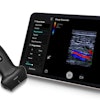
The addition of an onsite radiology service including point-of-care ultrasound (POCUS) at the US Open tennis tournament has enabled sports physicians to streamline medical care for athletes. Researchers described their experience in a July 25 article in Skeletal Radiology.
The presence of an onsite POCUS capability at the US Open has given tournament doctors access to a quick and relatively inexpensive tool for quickly evaluating musculoskeletal injuries, according to a team led by Dr. Carlos Benitez of Mount Sinai Hospital.
"The purpose of creating an onsite radiology service at the US Open was to provide quick and effective radiological examinations that would streamline the ability to provide comprehensive medical care for the athletes," Benitez et al wrote.
Mount Sinai has provided imaging services to the US Open since 2013. In 2015, this has been supplemented by adding a POCUS scanner onsite at the tournament venue, with a musculoskeletal radiologist added to the onsite medical team. A radiography system is also available onsite, with other modalities like MRI and CT performed at Mount Sinai. A PACS workstation onsite enables the interpretation of images of athletes acquired at either location.
In the current study, Benitez et al describe how the imaging service was set up. Imaging equipment would be transported to the tournament venue several days before matches began to test and optimize machines. Three musculoskeletal radiologists would be assigned to the tournament, with one scheduled to be at the stadium on any given day.
The ultrasound scanners used were portable laptop systems mounted on carts that were moved into the player treatment area. Each scanner was outfitted with a musculoskeletal software package, including high-frequency transducers of up to 18 MHz.
Among the types of scanning performed, power Doppler was conducted routinely to evaluate tissue hyperemia, while dynamic ultrasound scans were performed to analyze muscle contraction, tendon movement, and laxity of joints. On a few rare instances, vascular studies were performed to evaluate deep venous thrombosis in upper and lower extremities.
If ultrasound wasn't able to provide a definitive diagnosis, athletes were referred to the MRI scanner at Mount Sinai, such as for intra-articular injuries or stress fractures. A portable x-ray system in a separate room at the stadium was used for players who sustained trauma to evaluate osseous injury. Onsite radiography was the least-used of the three modalities, Benitez et al noted.
How often was POCUS used onsite? The researchers calculated a total of 339 ultrasound scans conducted from 2015 to 2021, a yearly average of 49 scans. The most common injuries seen were in the muscles and tendons, and the anatomical regions scanned most often where the thighs and abdominal wall. By comparison, an average of 11 MRI scans were performed each year, for a total of 89 studies.
Interestingly, Benitez et al found gender differences in how ultrasound was used between the players. Sonography was used more often for women athletes for all upper extremity issues, such as the hand and wrist. For the lower extremities, scans of the feet were most common in women. For men, ultrasound was used more often for the calf and ankle.
What were the benefits of having POCUS onsite at the US Open? Benitez et al identified three main advantages:
- A streamlining of treatment workflow, with faster turnaround times
- Better communication between members of each athlete's medical team and radiologists
- Better consistency of radiology reports by ensuring that there was a single person in charge of all imaging modalities
The researchers debated the value of having an onsite MRI scanner in a mobile coach at the stadium, which would make it more convenient for injured athletes who would no longer have to leave the tournament site. The additional cost of such a system could be justified for major Grand Slam or Masters tournaments, and could possibly be supported by advertising sponsors.
"The US Open point-of-care radiology service was a valuable addition to the tournament medical group, providing the comprehensive and effective medical care needed in a major professional tennis event," the authors concluded.



















